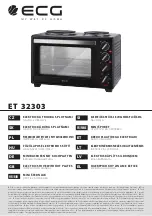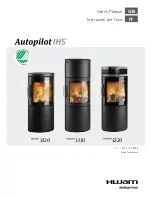
GB
14
QUICK LIGHTING
It is important that the wood catches fire
quickly. Quick lighting is achieved by opening
the combustion air damper fully or by leaving
the door in the lighting position for a moment.
Smouldering, i.e. reduced air supply, results
in poor combustion and efficiency with high
emission discharges and can, in worst-case
scenarios, cause rapid gas ignition resulting in
stove damage.
Wood loading
1. Open the door handle slightly and let the vacuum in the firebox equalise
for a few seconds before opening the door completely.
2. Add 2-3 logs of a combined weight of approx 1.5-2.2 kg. One log is
placed diagonally and one or two
logs are placed parallel to the
back, see illustration to the right.
Then close the door.
3. The combustion damper must be
completely open for 3-5 minutes
until the logs turn black and
catch fire. If you wish for slower combustion, the supply of combustion
air can now be reduced. The conditions for controlling combustion
vary depending on the temperature in the stove and the draft in the
chimney.
4. The lowest output of 4 kW is usually obtained when the combustion
damper is 45% open and two logs are lit. In this operating mode it is
important that the combustion air damper is fully open for the first
3-5 minutes so that the wood has the chance to ignite fully before the
supply of combustion air is reduced. A condition of being able to control
the heat output is a thick bed of embers and a high temperature in the
firebox. When the fire has burnt down to embers is the time to add
more wood.
DEFRA exempted
The stove can be used in Smoke Control Areas. Smouldering, i.e. reduced
air supply, are prevented by blocking the combustion damper of 4 kW
output.
Lighting
If your house has mechanical exhaust air ventilation you will need to open
a window near the stove before lighting the fire. Leave the window open for
a few minutes until the fire has caught.
1. Open the controls for the combustion air fully.
2. Place some newspaper or a fire
lighter block, and approximately
2,5 kg kindling in the middle of the
stove. The wood should be piled
alternately across and lengthways.
3. Light the fire.
4. The hatch is set to the lighting position, i.e. the outside of the lower
locking hook must lie against the lock reel. If the air gap between the
hatch and the body is too large a whirlwind is created in the stove and
the flames will hit the side glass resulting in sooting. When the fire has
caught fully after approx 10-15 minutes, close the hatch completely.
A fresh load of logs should not be put on until the start-up fire has
become a glowing bed of embers.
Correctly sized wood
Note that if too little kindling is used when lighting, or if the wood is too
thickly cut, the fire box will not reach the correct operating temperature.
Incorrect lighting can lead to poor combustion with heavy sooting and may
result in the fire going out when the door is shut.
Kindling wood: Finely chopped wood
Length: 25-35 cm
Diameter: 3-4 cm
Weight per lighting: 2.5 kg (approx. 10 - 12 finely chopped pieces)
Feeding Wood: Chopped wood
Length: 25-35 cm
Diameter: 6-7 cm
Normal weight: 1.5 kg/hour
Max weight: 2.5 kg/hour (2-3 logs per load)
Normal refueling interval: 50 minutes
LIGHTING IN THE RIGHT WAY
It is important that the correct amount of wood is used, especially when
lighting. If you are lighting the fire for the first time you should use a set
of scales to see how much 2.5 kg kindling is. Also check what the normal
and maximum weights look like.
The stove is only intended for use with the door closed and it is only then
that the hot air flushing of the glass surfaces occurs. Always open the door
carefully and slowly to prevent blow back because of the changing pressure
in the stove.
The function of stoves differs depending on the draft conditions in the
chimney. Achieving the correct setting for the combustion air damper
usually takes a few attempts.
In order to obtain a good bed of embers, there should always be a thin
layer of ash and charred pieces in the stove.
Содержание Contura C30
Страница 1: ...Lighting instructions C30 contura eu...






















